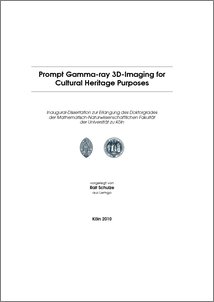Schulze, Ralf
(2010).
Prompt Gamma-ray 3D-Imaging for Cultural Heritage Purposes.
PhD thesis, Universität zu Köln.

![[img]](https://kups.ub.uni-koeln.de/style/images/fileicons/application_pdf.png)  Preview |
|
PDF
Ralf_Schulze_-_Prompt_Gamma-ray_3D-Imaging_for_Cultural_Heritage_Purposes.pdf
Download (16MB)
|
Abstract
The development of new, and the enhancement of existing element-sensitive imaging methods utilizing neutrons of different energy regions was the aim of the European ANCIENT CHARM project. During the present work the setup for Prompt Gamma-ray Activation Analysis (PGAA) at the research reactor FRM 2 in Garching near Munich was modified to enable the spatial mapping of elemental abundances in the analysed samples. Because the PGAA setup at FRM 2 was under construction at the beginning of the project first tests and the development of calibration and measurement procedures for the new imaging method were done by the PGAA group at the Budapest Research Reactor in cooperation with the Institute for Nuclear Physics of the University of Cologne. Due to the higher neutron flux at the PGAA setup at FRM 2 the equipment was transferred from the Budapest Research Reactor to FRM 2 after the PGAA setup at FRM 2 started its regular operation. After further optimizations and the characterization of the setup, measurements were started on replicas of real archaeological objects before several measurements on real objects were performed and analysed. Several measurement configurations were applied. Additional to 2D and 3D imaging measurements a new application for the measurement of thin surface layers in the order of a few 100 micro-meters was developed. For the quantitative analysis of elemental distributions the exact knowledge of the neutron flux at each measured position in the analysed sample has to be known. Based on the well-established cold Neutron Tomography (NT) method a method and software have been developed, which enables the calculation of the neutron flux inside samples with the map of attenuation properties obtained through NT. A new data acquisition system was developed for the regular operation of the PGAA setup at FRM 2, which supports traditional bulk PGAA measurements as well as measurements in the new imaging configuration. The high automation of the system allows a significantly more efficient use of the available measurement time than it was the case before. The new software �HDTV� for the analysis of gamma-ray spectra, which is currently under active development at the Institute for Nuclear Physics of the University of Cologne, was extended by some functionality for the analysis of PGAA spectra. It is a proposed modern successor of the currently used software �TV� and allows the semiautomatic analysis of multiple, similar spectra, what is essential for the new imaging PGA method.
| Item Type: |
Thesis
(PhD thesis)
|
| Translated title: |
| Title | Language |
|---|
| Prompte Gamma 3D-Bildgebung für die Analyse von Kulturerbe-Objekten | German |
|
| Translated abstract: |
| Abstract | Language |
|---|
| Die Entwicklung von neuen und die Verbesserung existerender element-sensitiver, bildgebender Verfahren mit Hilfe von Neutronen verschiedener Energiebereiche war das Ziel des europäischen ANCIENT CHARM-Projektes. Während der vorliegenden Arbeit wurde als Teil dieses Projektes die Station für Prompte-Gamma-Aktivierungs-Analyse (PGAA) am Forschungsreaktor FRM 2 in Garching bei München modifiziert, um die ortsauflösende Bestimmung elementare Verteilungen zu ermöglichen. Da sich die PGAA-Station am FRM 2 zu Beginn der Arbeit noch in der Fertigstellung befand wurden erste Tests und die Erarbeitung von ersten Kalibrierungs- und Messprozeduren für die neue bildgebende Methode von der Budapester PGAA-Gruppe in Kooperation mit dem Institut für Kernphysik der Universität zu Köln am Budapester Forschungsreaktor vorgenommen. Auf Grund des höheren Neutronenflusses der Garchinger PGAA-Station wurden nach der regulären Inbetriebnahme der Station die benötigten Gerätschaften vom Budapester Reaktor zum FRM 2 verlegt. Dort wurden weitere Optimierungen vorgenommen und die Eigenschaften des Aufbaus charakterisiert. Nach ersten Testmessungen mit Repliken von archäologischen Objekten wurden mehrere Messungen an echten Objekten von ärchäologischem Interesse durchgeführt und analysiert. Hierbei wurden verschiedenen Messkonfigurationen angewendet. Neben bildgebenden 2D- und 3D-Messungen wurde auch eine neue Anwendung zur Messung dünner Oberflächenschichten im Bereich von eingen 100 Mikrometern entwickelt. Für die quantitative Bestimmung von elementaren Verteilungen ist u. a. die genaue Kenntnis des Neutronenflusses an jeder gemessenen Position innerhalb der analysierten Probe nötig. Mit Hilfe der etablierten Methode der kalten Neutronen-Tomographie (NT) wurde ein Verfahren mit zugehöriger Software entwickelt, durch welches sich der erwartete Neutronenfluss innerhalb von Proben aus der mit NT gemessenen Abschwächungs-Verteilung für kalte Neutronen bestimmen lässt. Zur regulären Inbetriebnahme der PGAA-Station am Garchinger Forschungsreaktor wurde u. a. ein neues Datenaufnahmesystem beigetragen, welches sowohl traditionelle PGAA-Messungen, als auch Messungen mit der neuen Methode der bildgebenden PGA erlaubt. Durch die hohe Automatisierung erlaubt die neue Datenaufnahme einen deutlich effektiveren Betrieb der PGAA-Station, als es bisher der Fall war. Die neue, momentan am Institut für Kernphysik der Universität zu Köln entwickelte Software für die Analyse von Gamma-Spektren �HDTV� wurde um einige Funktionalität zur Analyse von PGAA-Spektren erweitert. �HDTV� ist als zukünftiger moderner Nachfolger für die bisher genutzte Software �TV� vorgeschlagen und erleichtert bspw. die halb-automatische Analyse von vielen, ähnlichen Gamma-Spektren, was für das neue bildgebende PGA-Verfahren essenziell ist. | German |
|
| Creators: |
| Creators | Email | ORCID | ORCID Put Code |
|---|
| Schulze, Ralf | ralf.schulze@ikp.uni-koeln.de | UNSPECIFIED | UNSPECIFIED |
|
| URN: |
urn:nbn:de:hbz:38-31519 |
| Date: |
2010 |
| Language: |
English |
| Faculty: |
Faculty of Mathematics and Natural Sciences |
| Divisions: |
Faculty of Mathematics and Natural Sciences > Department of Physics > Institute for Nuclear Physics |
| Subjects: |
Physics |
| Uncontrolled Keywords: |
| Keywords | Language |
|---|
| Ancient Charm, Neutronen, elementare Bildgebung, PGAI, NT | German | | Ancient Charm, Neutrons, Elemental Imaging, PGAI, NT | English |
|
| Date of oral exam: |
4 July 2010 |
| Referee: |
| Name | Academic Title |
|---|
| Jolie, Jan | Prof. Dr. |
|
| Refereed: |
Yes |
| URI: |
http://kups.ub.uni-koeln.de/id/eprint/3151 |
Downloads per month over past year
Export
Actions (login required)
 |
View Item |


